Blog
Archives
.
. . from 2012 to current
SUNDAY
16 AUGUST 2015
Blackcaps
on Brook Meadow
Malcolm
Phillips had an early morning walk around Brook Meadow
and was surprised at how many female Blackcaps were
present. He saw four of them in the trees on the
causeway and another three by the gas holder. That is
very good news as it could mean at least seven pairs
were breeding on the meadow this year, which is more
than we usually get. Here are photos of two of the
female Blackcaps that Malcolm got.
Sparrowhawks
at Nore Barn
Malcolm
Phillips then went over to Nore Barn where he saw two
Sparrowhawks flying over the woods. That is also good
news as it probably means these birds nested again in
Nore Barn Woods as they have done for several years.
Malcolm's photo could be of a juvenile bird as its
plumage a rather browner than one might expect in an
adult.
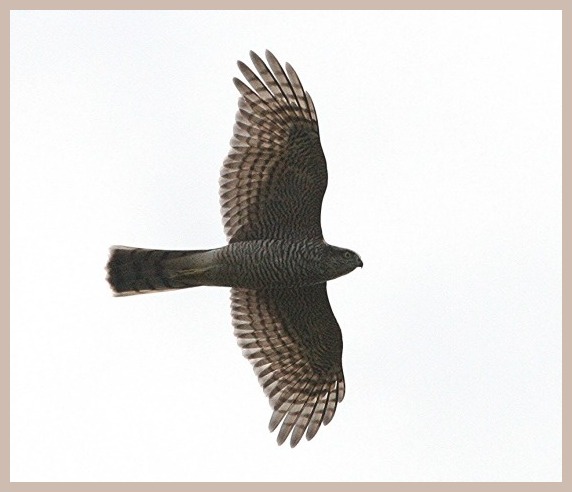
Warblington
shore
Peter
Milinets-Raby says the Warblington shore has been very
quiet over his last few visits and this morning's was
no exception. The highlights from the last few visits
have been:
11th August: 1 Spotted Redshank, 47 Dunlin, 25 Grey
Plover
12th August: 25 Common Tern, 1 summer plumaged
Knot.
15th August: 1 Sedge Warbler, 2 Willow Warbler, 22
Ringed Plover.
Today's unremarkable
highlights were as follows (6:26am to 8:55am):
Ibis Field: 1 Sedge Warbler
Hedgerow behind Conigar Point: 1 Whitethroat, 1
Willow Warbler.
Conigar Point - extremely low tide! 1 Lesser
Black-backed Gull, 4 Common Gull, 6 Canada Geese east,
1 Common Sandpiper in the stream (my second sighting
this autumn!), 6 Grey Plover, 14 Ringed Plover, 17
Dunlin, 1 Black-tailed Godwit, 3 Lapwing, 1 Common
Tern, 1 Willow Warbler in the Tamarisk hedge.
Off Pook Lane: 7 Greenshank (just one with
rings - G//R+YN//-), 7 Grey Plover, 1 Dunlin, 15
Little Egrets feeding in the trickle of water in the
channel, 4 Common Gull, 1 Whimbrel, 1 Common Tern, 1
Buzzard.
Langstone Mill Pond: 6 Swallow, Grey Heron
young still in the top nest in the Holm Oak - almost
fledged! 27 Little Egrets loitering - 10+ are
juveniles. 2 juvenile Tufted Duck getting older and
very independent (see photo) - no sign of mum. 4 Reed
Warbler seen.
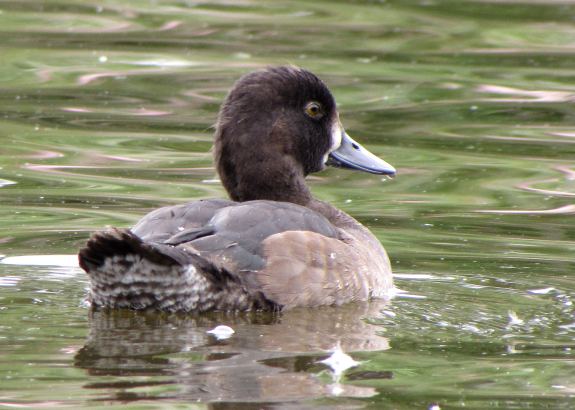
SATURDAY
15 AUGUST
Brook
Meadow
Malcolm
Phillips had a good morning for dragonflies on the
meadow getting excellent images of both male and
female Common Darters. These are relative small
dragonflies, but fairly easy to identify.
Malcolm also got what
looks like an immature Southern Hawker. The
adults are much brighter green. These are fairly
common on Brook Meadow at this time of the year and
often fly quite close to you.
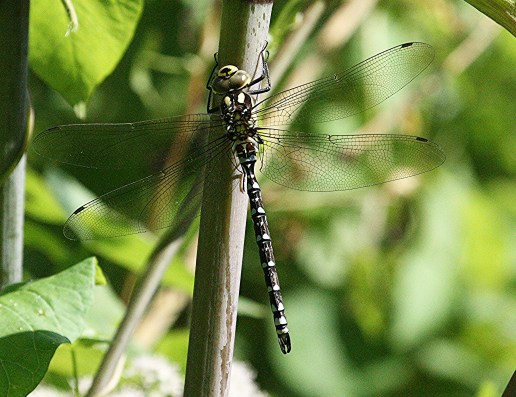
Malcolm also captured
these two birds reaping the rich fruit harvest that
Brook Meadow now provides; a Blackbird taking
Alder Buckthorn berries and a Greenfinch
tucking into a juicy Blackberry.
Groundhopper
on Hampshire Farm
Chris Oakley
sent me a photo of this Groundhopper that he took on
the Hampshire Farm site this afternoon.
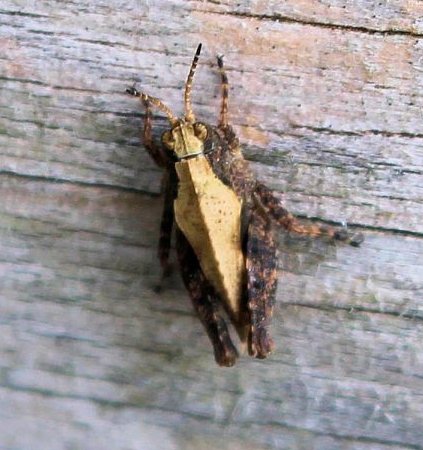
Groundhoppers are a
bit like grasshoppers, but as can be seen in Chris's
photo, the pronotum extends back over the whole top of
the abdomen. The forewings are reduced to small
scales, but hind wings are usually well-developed.
They are active all the year in sunshine, preferring
bare and sparsely-vegetated ground. There are three
species in Britain, of which Common Groundhopper and
Slender Groundhopper are the most common.
I am certainly no authority on these insects, but
comparing Chris's photo with those on the internet my
guess is that his insect is a Common Groundhopper
(Tetrix undulata) as the pronotum is
relatively short. The pronotum of a Slender
Groundhopper (Tetrix subulata) would be
longer. I would appreciate any help for clarify
thisidentification.
For more information and photos go to . . .
http://www.naturespot.org.uk/species/common-groundhopper-0
. . . and . . . http://www.naturespot.org.uk/species/slender-groundhopper
FRIDAY
14 AUGUST
Brook
Meadow management
This morning,
in light drizzle, I met up with Gareth (an ecologist
from Aluco Ecology) and Jennifer Rye, Maurice Lillie
and David Search from the Brook Meadow Conservation
Group. We had a very useful and informative discussion
regarding management of the grassland of Brook Meadow.
Regarding the northern part of the north meadow it was
thought to be a good idea to try to reduce the
dominance of Tall Fescue, which currently dominates
the area to the exclusion of most other plants. It was
decided to create a couple of experimental areas which
would be cut hard and scraped and then sown with
Yellow Rattle seeds collected from the orchid area,
along with Meadow Barley and Corky-fruited
Water-dropwort seeds provided by Gareth. Thanks to
Malcolm Phillips for the photo.
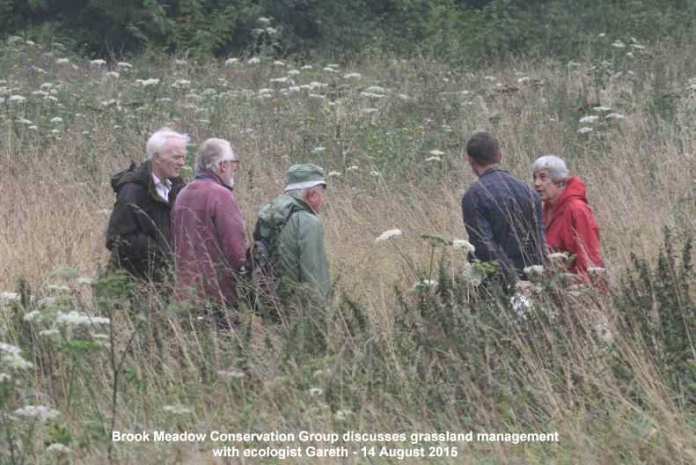
After much discussion
it was thought best not to change the management of
the main orchid area as this area is functioning quite
well at present, nor the Lumley area. However, the
sedgey area above the causeway and the south meadow
will probably need extra management. Martin Cull will
be asked to carry out some extra cutting and clearing
this autumn.
Peter
Pond Trout
On Aug 1st,
Malcolm Phillips met Steve Hooper at the top of Peter
Pond to have a look at Brown Trout that Malcolm has
been photographing over the past few weeks in the pond
north of the footbridge. Steve is a retired
Environment Agency employee and a fish keeper with
more than fifty years experience. The large Trout that
Malcolm got did not show up today, but Steve was very
surprised to see what he called 'Brook Trout' as he
thought they had vanished years ago. Steve stayed for
about 2 hours and Malcolm found him very interesting
and full of information.
Here is a photo
the Malcolm got of some Brown Trout in the Lumley
Stream on July 5th.
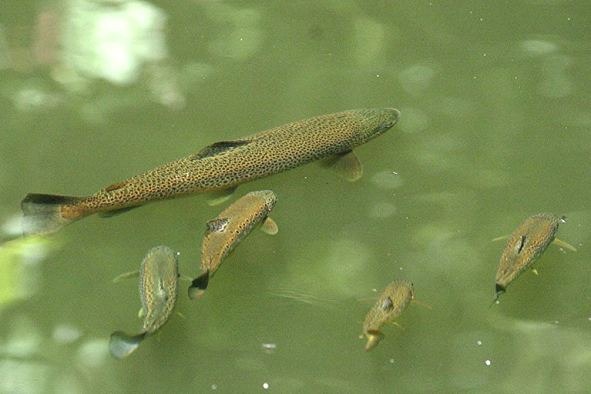
Brook
Trout
Here is some
information on Brook Trout that I gleaned from the
internet.
It is not native to Britain and originates from
America. With a greeny brown tinge to its flanks and
its white tipped pectoral, anal and pelvic fins, this
is a beautiful species of Trout. The Brook Trout's
tail fin is square but is rare occasions it can have a
slight fork to its shape. The average size of an adult
Brookie ranges between 10 to 12 inches.
Brook Trout prefer cooler waters and will spend their
time feeding in shallow pools. Once more confident
they will explore deeper waters. They will lay
stationary in areas of weed, under cut banks and
around boulders and logs, Brook Trout tend to favour
clear clean water. They are popular with anglers due
to their fighting behaviours and their impressive
determination to escape. Here is a photo of one caught
in Scotland that I got from the internet.

THURSDAY
13 AUGUST
Emsworth
Harbour
15:00 - Tide
falling. I started by having a quick look at Nore Barn
where I found the regular Greenshank G+GL
feeding in the stream all alone. The Spotted Redshank
is not expected until early October at least, but one
never knows these days. The only other birds in the
stream were three Mute Swans, a Little Egret and
several Black-headed Gulls.
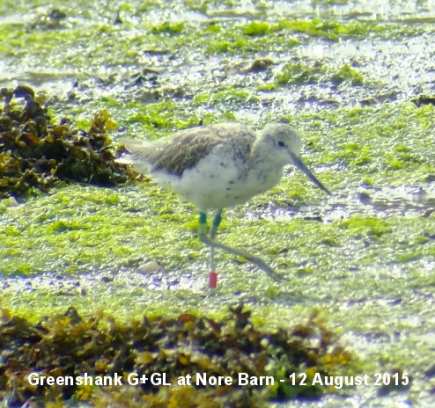
15:30 - I went over to
the eastern harbour to wait for the godwits to arrive,
but they just did not turn up in any numbers, like
they did yesterday. It was very hot so maybe they were
having a snooze in the shade somewhere.
WEDNESDAY
12 AUGUST
Emsworth
Harbour
14:30 - I
popped down to marina seawall about 3 hours after high
water with the tide was falling rapidly. I had to wait
for 30 minutes before the waders came onto the
emerging mudflats, first Redshank and Greenshank then
Black-tailed Godwits.
I counted a total of 87 Godwits, so numbers are
building up. I noticed a godwit with a shell clamped
to its foot, like the one last week. This must be a
fairly common risk for waders in the harbour?
Fortunately the shell appears to do no harm as it
falls off after a short period. I could only find one
colour-ringed bird: Black-tailed Godwit G+WR.
This was my 3rd sighting of this bird this autumn and
my 115th sighting of this very regular godwit in
Emsworth Harbour since Nov 2008.
I also spotted a
couple of colour-ringed Greenshank:
Greenshank G+BL tag - I first saw this bird in
Emsworth Harbour on 09-Apr-14. The black round tag is
very prominent on the blue ring.
Greenshank G+YG - This was my 4th sighting of
this bird in Emsworth Harbour since 23-Sep-13.
Previously seen this season on 05-Aug-15.
Hobbies
in Hollybank
Tom Bickerton
was caught in a traffic hold up on the Emsworth Common
Road to the north of Hollybank Woods when he clearly
heard young Hobbies calling from the woods. He thinks
the calls could be from the young of one of the two
pairs that nested close by. So, Tom says, if anyone is
about the Woods it would be worth just keeping an eye
(and an ear) open especially along the field margins
for these birds, and they may even be lucky enough to
witness the adults hunting swallows, which is a
fantastic sight.
TUESDAY
11 AUGUST
Swan
news
Brian Lawrence
came to Emsworth today and had a good view of the Mute
Swan family with 5 cygnets. He got a nice photo of the
famous white Polish cygnet conveniently showing a pink
leg and foot. Pink legs and feet are the main
distinguishing features of a Polish swan when it is
fully mature; normal adult Mute Swans have black legs
and feet.
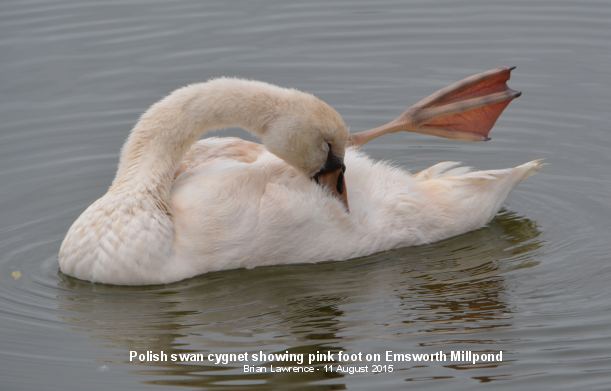
Peter
Pond
Malcolm
Phillips spent some time at one of his favourite spots
today on the Lumley Path footbridge at the top of
Peter Pond. He got several images of birds including a
cracking Goldfinch and what I think is a
Reed Warbler, though it could possibly be a
Cetti's Warbler if I could see it tail.
Hampshire
Farm
Chris Oakley
says the flock of Canada Geese that visited the pond
on the Hampshire Farm site have all gone, probably
back 'home' to Thorney Island. But, he says, like
human travellers they have left the place in a bit of
a mess. However, the Heron is back which is good to
see. The Mallard still has her full compliment of
eight ducklings which are now fully grown. Just as
well they are as this Heron could easily snap them up.
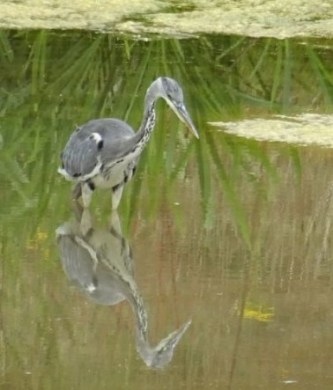
For more details go to
Chris's dedicated web site at . . . http://hampshire-farm-meadows.simplesite.com/418799085
MONDAY
10 AUGUST
North
Thorney
I intended to
have a look at the eastern harbour, but I misjudged
the tide , so instead I had a walk along the old ERA
track which was very quiet indeed. However, it was
good to see several Swallows flying around,
which presumably meant they had nested successfully
again in the stables. There were plenty of wild
flowers alongside the track including good quantities
of Stone Parsley and Great Willowherb, plus
lots of big juicy blackberries.
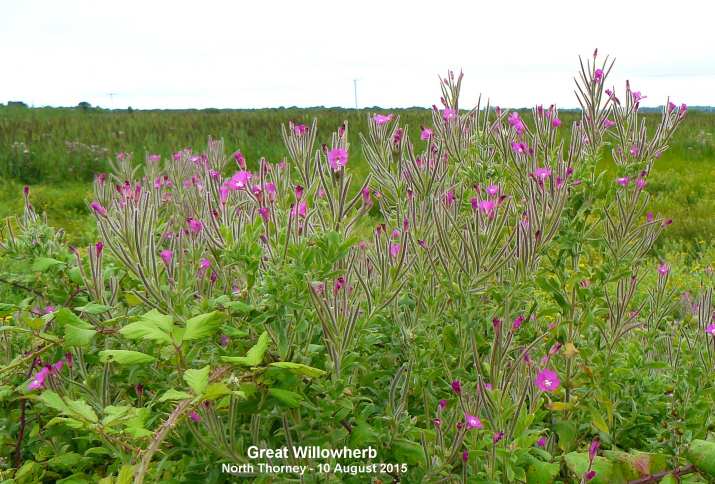
I came back along the
footpath through the old Marina Farm (south of the
Deckhouses Estate) which has been a rather run down
stables for many years since the farm closed down. The
stables are currently completely deserted with no
horses, people or vehicles anywhere. There is a notice
on the eastern gate that due to a family bereavement
the gate will be locked until further notice, but this
does not affect access along the footpath through the
farm area. The rough barren ground immediately west of
the stables has a mixture of plants, including quite a
lot of what I think is Red Goosefoot. This is a
dark green fleshy plant, but not mealy, like other
Goosefoots. The leaves are diamond-shaped and well,
but irregularly, toothed.
Hampshire
Farm
Early this
evening, Chris Oakley saw 54 Canada Geese fly
onto the Hampshire Farm pond. These are probably the
Thorney birds that often go for a fly around the area
in a large flock. Hilary Gilson recently reported them
over Prinsted. They also occasionally visit the
Emsworth millponds and many years ago I recall seeing
them on Aldsworth Pond. It looks as if they have
discovered this new pond in North Emsworth, so they
may become fairly frequent visitors.
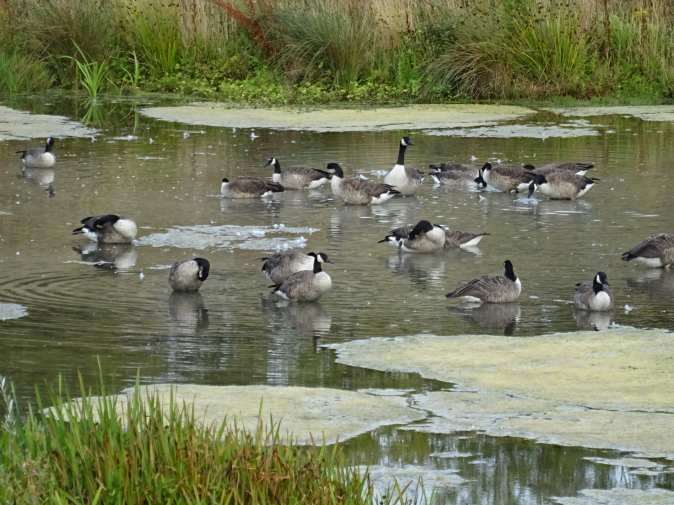
Warblington
shore
Peter
Milinets-Raby popped down to the Warblington shore
this morning at 11:15am for an hour. The tide was
beginning to drop and expose the mud.
Off Pook Lane: 22 Dunlin, 1 Spotted Redshank
(hiding in with the Redshank, but soon vanished
into a muddy gully - winter plumage, with clean under
parts), 101 Redshank (two with colour rings -//B+B//YL
and -//B+B//YR - the last bird is new to me), 9 Grey
Plover, 1 Whimbrel, 2 Black-tailed Godwit.
Conigar Point: 9 Greenshank (only 3 of them with rings
- G//R+YN//- and GR//-+YY//- and B//R+GR//- ), 22 Grey
Plover, 12 Dunlin, 4 Ringed Plover (first of
the autumn - expect big numbers in the next week to
ten days), 1 Spotted Redshank (winter with a
tatty under belly and breast, so likely to be
different from the one seen earlier), 1 Lesser
Black-backed Gull, 1 Black-tailed Godwit.
Brian's note:
Good to see the arrival of Spotted Redshanks.
These are likely to be birds passing through on their
way further south. The Spotted Redshank that comes to
Nore Barn is not expected until early October.
Brook
Meadow - Blackcap
Malcolm
Phillips only had half an hour on the meadow today,
but managed to capture a good image of a female
Blackcap, which might be the mate of the male that
Malcolm got on Aug 8.
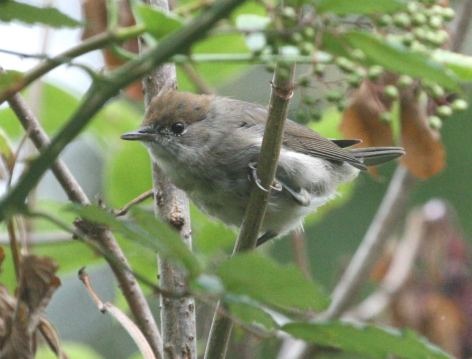
Mystery
Moths
Joyce Sawyer
sent me a photo that her husband took in their
Denvilles garden of what looks like two moths
mating, though what they are I have no idea. Can
anyone out there provide any clues to their identity?
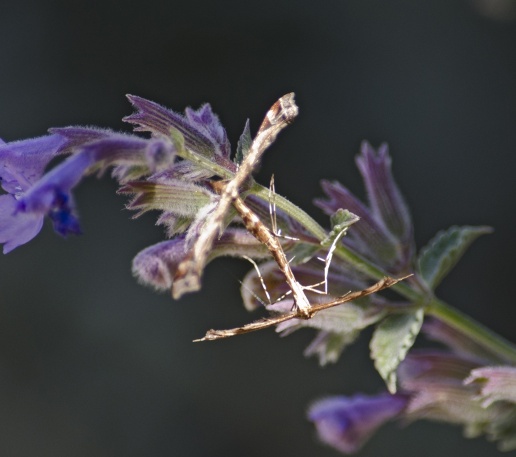
Eric Eddles replied
immediately to say the two moths sent in by Joyce
Sawyers are Plume moths - Amblyptilia
acanthadactylia. Eric sent a photo of one that he
took on his kitchen window in October 2011.
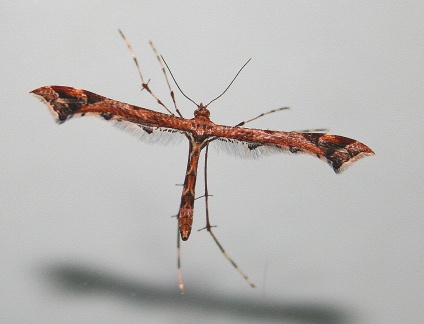
For
a summary of wildlife news over the past two weeks go
to . . .
Wildlife
News Summaries
SATURDAY
8 AUGUST
Brook
Meadow birds
Malcolm
Phillips had a walk around the meadow this morning and
got these two excellent images. The Song Thrush
on the left is singing its heart out, but for what
purpose? Surely he cannot still be looking for a
mate?
The male Blackcap on the right has hopefully
finished its breeding programme and looks as if it is
moulting prior to its long migration to its wintering
grounds, probably in the Mediterranean area.
Juvenile
Buzzard
David Minns
couldn't resist e-mailing me this afternoon to say he
had just watched a Buzzard wheeling its way northwards
up North Street right over his house! He said it was
over St James Church when he first became aware of it,
and it then circled its way up the street and
disappeared northwards. It was very clear and had
brightly marked underwings - perhaps a juvenile, David
thought. This could well have been a juvenile bird
from a nest on Lumley Mill Farm having a look around
the area. Juveniles do this and are sometimes seen on
Brook Meadow.
FRIDAY
7 AUGUST
Emsworth
Harbour (east)
Black-tailed
Godwits
12:00 - 12:30
- Low water. Harbour viewed from the Wickor Bank
44 Black-tailed Godwits were feeding on the mudflats
fairly close to the shore, so I had a good view of
them. Another 9 Black-tailed Godwits were on the edge
of the main channel, making a total of 53. Here are
just a few of the close ones in this shot.
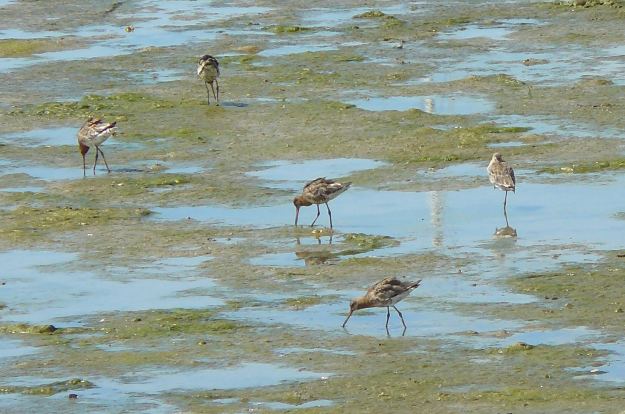
All these Godwits will
have recently arrived in Emsworth from their breeding
grounds in Iceland. They could have come direct, but
are more likely to have stopped off on the way for
food a and rest. Many, possibly most, of the birds
currently in Emsworth harbour will move further west
and south for the winter, probably crossing the
channel and even moving down into Spain and Portugal.
More Godwits will arrive as the autumn progresses and
some will stay with us for the winter. These wintering
birds tend to favour the mudflats to the west of
Emsworth at Nore Barn.
Most of the godwits
were in various stages summer plumage, though some had
lost this completely and already had their typical
grey winter plumage. Sorting out juveniles from among
such a variety of plumages is not easy, though I
suspect some of them will have been youngsters. They
will be easier to see later into winter. Here is one
possible juvenile Black-tailed Godwit.
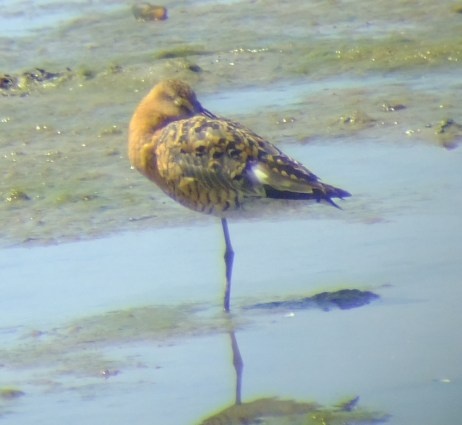
Colour-ringed
Godwits
Today's flock
included two colour-ringed birds:
R+RG which I had previously seen here two days
ago (05-Aug) when it had a shell clamped to one of its
feet. I was pleased to see the shell was no longer on
the bird's foot and it appeared to be moving around
freely. See photo.
O+WL, which was last seen in Emsworth by Peter
Milinets-Raby on 28-July. Today's sighting was our
11th for this bird in Emsworth Harbour since
25-Sep-12. See photo.
Redshank
Numbers of
Redshank had increased over the past couple of
days. Today I counted over 50, though many more were
probably hidden behind boats and in deep channels.
Most of them are still partly in their summer plumage,
like the one in this photo.
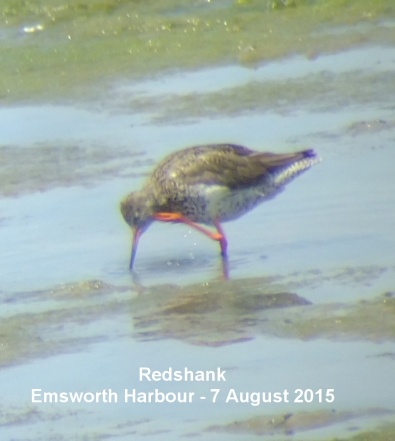
Emsworth
Millpond
Swan
cygnets
This morning
between 10:30am and 11:30am Peter Milinets-Raby took
his young son Aleksandr for a walk around the Emsworth
Mill Pond and to have a look over the harbour. Peter
was after photos of the Polish cygnet and it performed
very well indeed (see amusing photos showing
differences in plumage and bare parts).
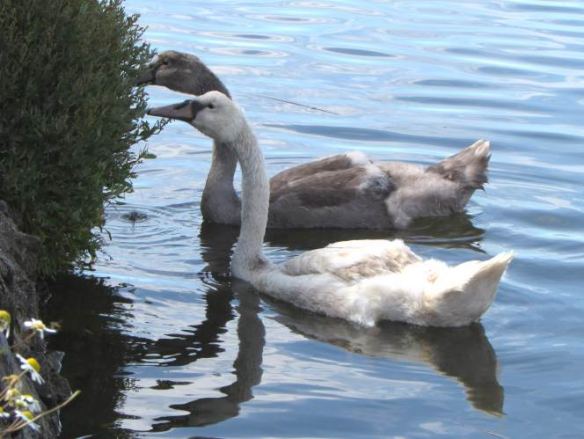
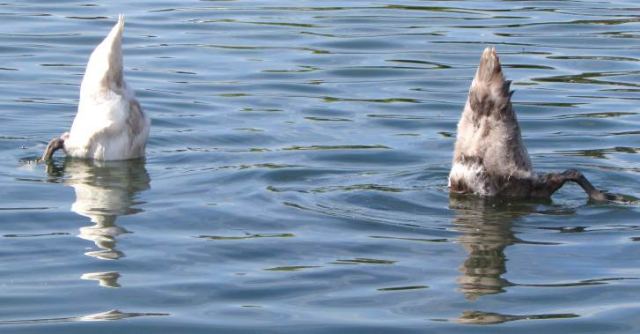
The other highlights
on the short trip were: On the mill pond with the
swans was a female Mallard with five tiny, itinerant
ducklings aimlessly wandering around, just asking for
trouble.
On the harbour: 41 Black-tailed Godwits, 2 Greenshank,
1 Turnstone, Lesser Black-backed Gull, 2 Little
Egrets. And a calling Buzzard soaring over.
THURSDAY
6 AUGUST
Peter
Pond
Malcolm
Phillips got a photo of some Brown Trout that can
still be seen from the small footbridge north of Peter
Pond.
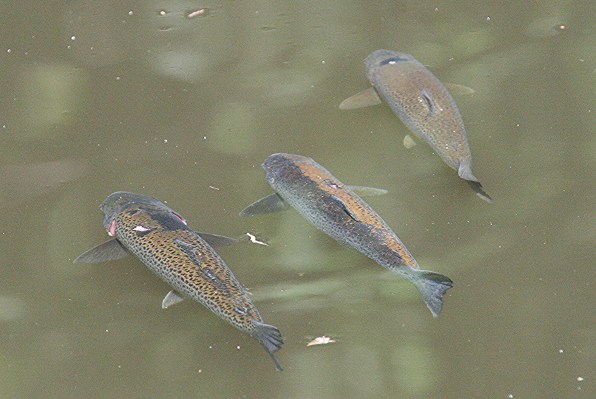
Malcom also came
across a Mallard duck with one small duckling - a late
brood. I gather from the notices posted around the
town millpond that there have been some ducklings
there too.
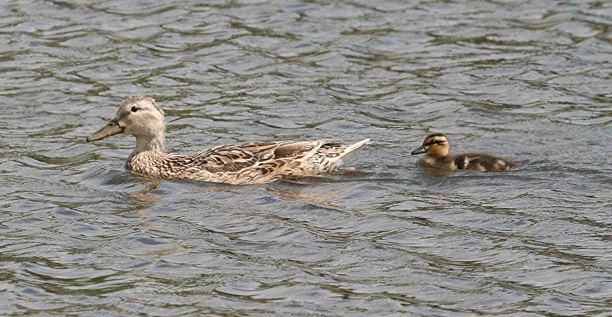
Langstone
Mill Pond
Peter
Milinets-Raby had a short 50 minute visit to the
Langstone Mill Pond this morning from 11:20am. Tide a
long way from coming in.
Off shore: 2 Black-tailed Godwit (fading summer
plumage), 16 Grey Plover (3 in winter, the rest in
summer), 2 summer plumaged Bar-tailed Godwit, 10
Dunlin (all summer), 2 Common Tern, 2 Greenshank, 1
Whimbrel, 2 Common Gulls, 3 Med Gulls (adult winters),
90+ Redshank.
In the distance on Conigar Point were 6 Grey Plover, 2
Dunlin and a feeding flock of 21 Common Terns.
Langstone Mill Pond: 1 Kingfisher darting about, 17
Swallow over the pond, Mute Swan family in residence.
No sign of tiny ducklings from the other
day.
Insect
corrections
Ralph Hollins
provided valuable information about some of the
insects I photographed on Brook Meadow on Aug 4th.
First, he thinks the two unknown bees on a Spear
Thistle were Honey Bees though admits he may be
wrong! I think he is correct, though neither of them
appears to have any pollen sacs on the legs which
suggests they may be males (drones).
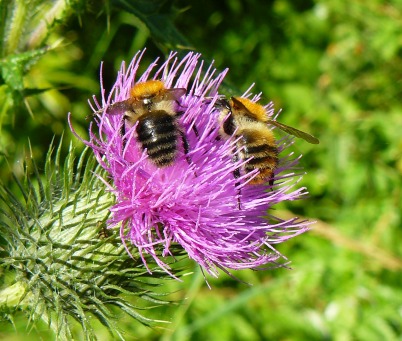
Secondly, Ralph says
the Short-winged Conehead is especially short
winged as it is a nymph and has no wings - the
give-away is the black streak down the back where a
mature adult has a brown streak.
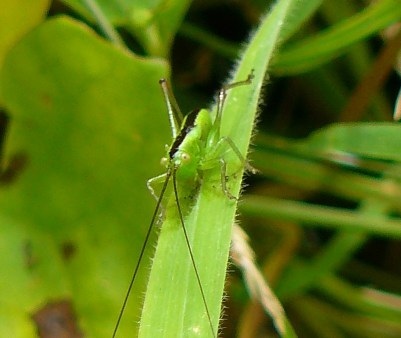
For photos of a
Short-winged Conehead nymph go to . . .
http://www.imageinuk.com/Bush-Crickets-Gryllidae/Conocephalusdorsalis/10374691_JhWz77#!i=556061477&k=4CX924G
For an adult male
Short-winged Conehead go to . . . http://www.pyrgus.de/Conocephalus_dorsalis_en.html
WEDNESDAY
5 AUGUST
Emsworth
Harbour
I got down to
the marina seawall at 10.30 this morning with the tide
well out in the eastern harbour. The weather was
cloudy with a brisk southerly wind, fairly good
viewing conditions. I counted 41 Black-tailed
Godwits on the mudflats, along with 4 Greenshank,
10 Redshank, 1 Turnstone, 4 Curlew and 1 Whimbrel.
There was a small group of 7 Godwits fairly close to
where I was standing which included a colour-ringed
bird: R+RG. I have no previous records of this
godwit in Emsworth though Peter Milinets-Raby saw it
at Warblington on 27-Nov-14.
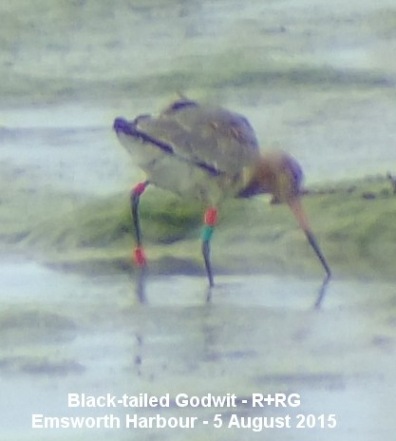
While I was watching
the Godwits, I noticed the ringed godwit shaking its
foot due to a shell clamped to it. This seemed to
produce some consternation among the other godwits in
the group which gathered around to have a look. The
affected godwit was clearly distressed and flew off
calling loudly. I have come across cases of shell
attachment before and I gather the shell eventually
drops off when the animal inside needs to feed. The
affected bird is on the far right in the photo.
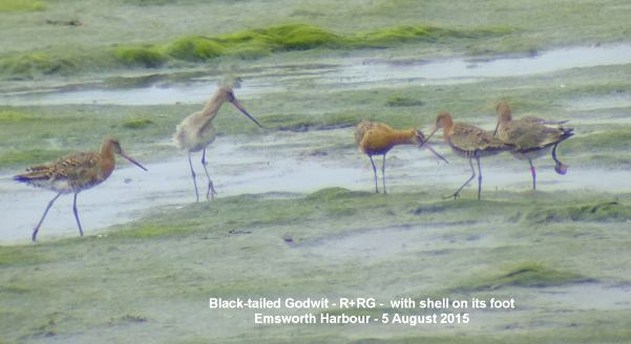
I also noted a
colour-ringed Greenshank G+YG. I have only two
previous records of G+GY in Emsworth Harbour:
23-Sep-13 and 01-Apr-15.
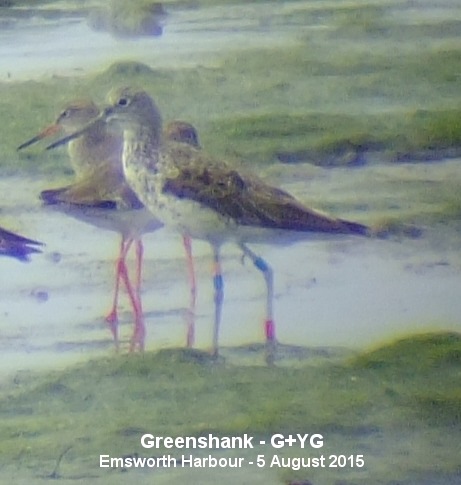
I had a quick look at
the western mudflats where I found the first 3
Shelduck of the new season.
Nore
Barn
After lunch, I
went over to Nore Barn by 13.30 to catch the rising
tide. All was very quiet with only a Little Egret and
the regular colour-ringed Greenshank G+GL
feeding in the stream. This Greenshank was previously
seen here by Peter Milinets-Raby on 28-Jul-15. 17 Mute
Swans were further out in the harbour.
The bright yellow flowers of Golden Samphire
are now well out along the sea wall south of the
woods. I captured this white-tailed Bumble Bee -
probably a male Bombus terrestris -
feeding ravenously on the flowers.
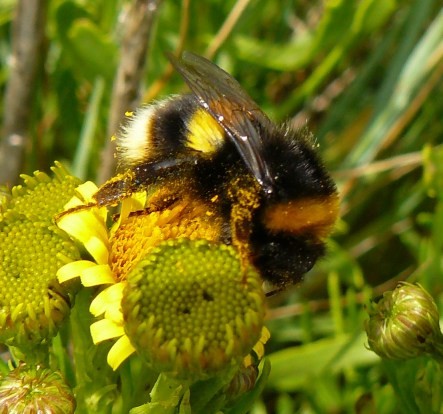
Sea Aster is
also in flower on the saltmarshes, plus lots of what I
assume is Lesser Sea-spurrey alongside the path
towards the picnic table.
There were quite a few feathers on the shore from
moulting birds. I picked up two which were in
reasonable condition. The first one (on the left in
the photo) was white with a black edge and tip and
clearly belonged to a Black-headed Gull. The
other one (on the right in the photo) was also white
with light brown bars across it, probably a tail
feather from a Curlew, of which several were
present in the harbour.
Brook Meadow
Malcolm
Phillips only had a short time on Brook Meadow this
morning but came away with this excellent shot of a
female Common Darter.
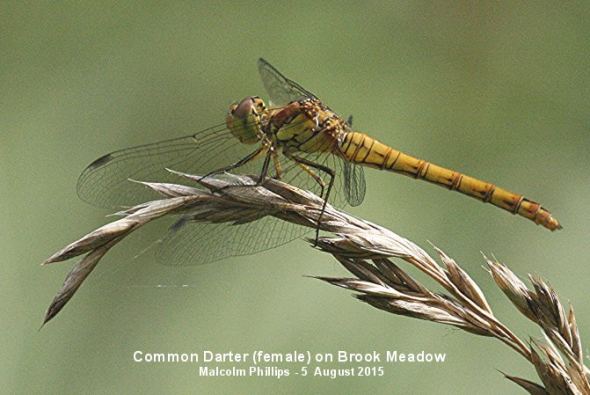
Warblington
shore
Peter
Milinets-Raby was down the Warblington shore yesterday
morning (Tuesday 4th August - 6:18am to 8:32am). The
highlights were:
Ibis Field: Lesser Whitethroat (a Whitethroat, 2 Reed
Warblers, 1 Sedge Warbler & a Willow Warbler were
seen on the 2nd), Male Pheasant.
Conigar Point: 4 Grey Plover, 7 Med Gulls (1 juv, 1
second winter and the rest were winter adults), 7
Common Gulls (no sign of the adult Yellow-legged Gull
seen on the 2nd), 3 Greenshank (RG//-+YY//- and
NR//-+YY//-), 1 Lapwing, 5 Common Terns.
Off Pook Lane: 15 Grey Plover (17 seen on the 2nd,
with 4 at Conigar Point), 2 Dunlin (10 seen on the
2nd), 3 Greenshank, 4 Common Gull, 2 Common Tern.
Langstone Mill Pond: (a single Teal was seen on the
pond on the 2nd).
Mute Swan family walked in from the low tide channel -
see video at https://www.youtube.com/watch?v=zgVg5MVFgmU

The Grey Heron second
brood are fairly grown now (3 of them) in top nest in
the Holm Oak, 36+ Little Egrets still loitering
(mostly juvs), Tufted Duck female with two growing
ducklings. The photo shows mum with one of the
ducklings.
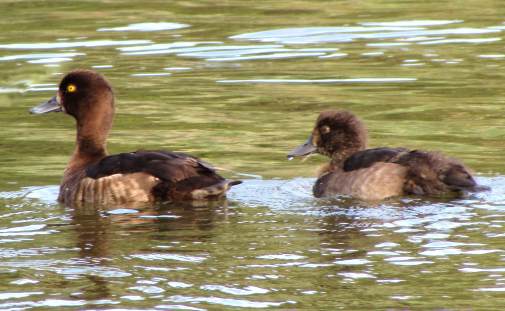
Female Mallard with 9
tiny ducklings (hours old!!!). Alas, when the Mute
Swans got back to the pond the male chased the
ducklings into the depths of the island and out of
sight. No idea what the outcome was. Almost certainly
not pleasant!
Galaxy
of gulls
In the huge
field to the north west of Eastleigh Road, (Denvilles)
at 3:15pm this afternoon Peter Milinets-Raby came
across hundreds of loafing gulls. 80% were just
resting, the rest were in a frenzy behind a tractor.
The field had been cut to stubble and a tractor was
raking the ground over, which was heaven to the gulls.
He counted 1670+ Black-headed Gulls, 27+ Med Gulls
(almost certainly more), 18+ Common Gulls, 4+ Lesser
Black-backed Gulls.
Also, in the air slightly north over the Private
Hospital along Barton's Road was an "ant feeding
spiral" containing another 400+ gulls (at least 5+ Med
Gulls noted amongst the Black-headeds), so over 2,000
gulls. I wonder how many were in the nearby harbours,
or were they eerily empty.
Hedgehogs
Caroline
French provided some useful information (with photos)
about the Hedgehogs that are living in her North
Emsworth garden. She says, "I've worked out that a
female and at least four young moved into the box in
my garden. I have only managed to see three young at
any one time over the past few days, so one may have
been lost, but not necessarily as they are easily lost
from view in the vegetation. The young are growing
quickly and are becoming more independent - a lady
across the road told me yesterday that she saw one in
her garden. There are at least two other adults
visiting my garden, one of which is a male. "
The
photo shows a Hedgehog drinking on the left and two
young Hedgehogs on the right
"Each evening I am
putting out dried mealworms, broken peanuts (not whole
ones, nor salted), raisins or sultanas and a few suet
pellets. The food is being taken every night but they
also seem to be successfully foraging for their own
natural food"
These
photos show the box that Caroline uses for the
Hedgehogs
Caroline provided the
address of the Hedgehog Street website which she says
is a great resource for people wanting to know how
they can help and encourage hedgehogs . . .
http://www.hedgehogstreet.org/
TUESDAY
4 AUGUST
Brook
Meadow
It was good to
get back to Brook Meadow after a few days in the West
Country visiting my family. However, it was quite a
shock to see the extensive clearance work by the
Environment Agency in removing brambles and other
vegetation from the bund between the south meadow and
the garden of Gooseberry Cottage. This photo is
looking south along the old Bramble path with the
clearance on the Gooseberry Cottage bund on the left.
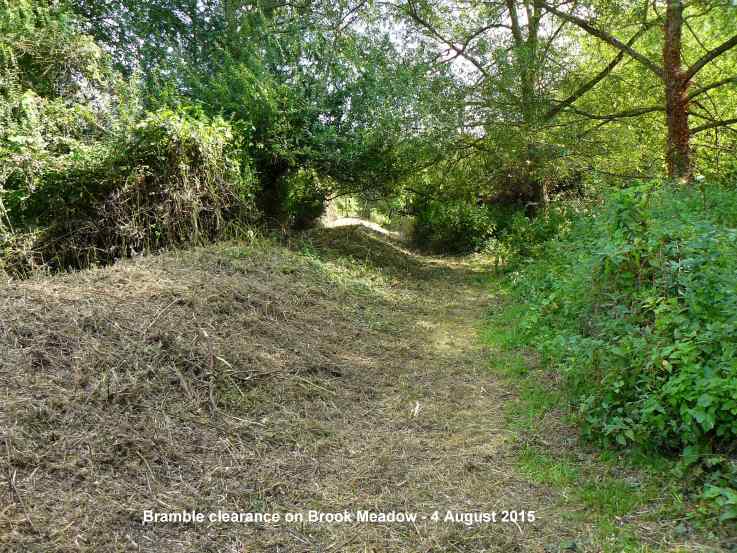
Much of the Bramble
hedge along the so-called Bramble path has gone and
the prized patch of Marsh Woundwort (our one and only)
at the northern end of the Bramble path has been
trampled, but not seriously damaged. Good to see the
conservation group has erected a notice at this point
indicating a wild flower regeneration area with no
access.
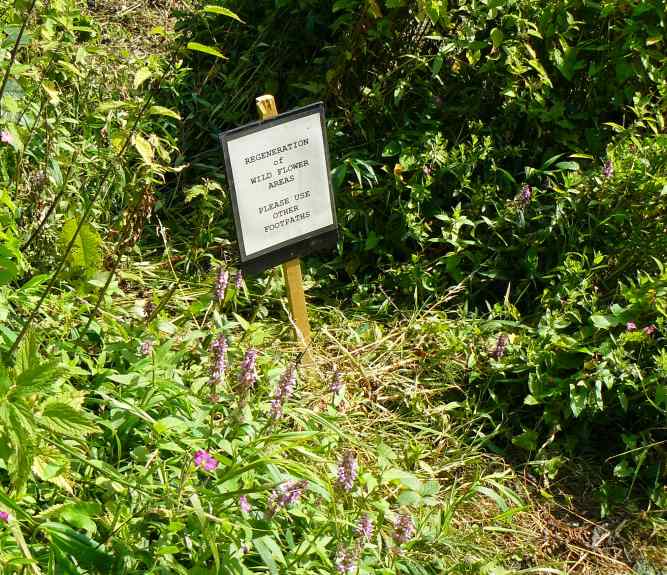
I gather this
clearance work by the Environment Agency has something
to do with the flood control measures currently being
undertaken, though mid-summer seems an odd time to
carry out this work with many birds probably having
late broods. If the Environment Agency can do all this
clearance, how is it they cannot clear the River Ems
on an annual basis like they used to? Looking on the
positive side this clearance could establish extra
habitats for wildlife in the area. I will include more
on this clearance when I understand just what is
happening.
It was good to see
lots of Bumblebees busy feeding and collecting
pollen from the later flowering plants: Bombus
pascuorum on Lesser Burdock, Bombus
lucorum on Hemp Agrimony, and Bombus
lapidarius with huge pollen sacs (obviously a
worker) on Common Fleabane. I also noted two other
Bumblebees feeding on the Spear Thistle in the south
eastern corner - not sure what they are.
First flowering of
Hoary Ragwort on the orchid area - well nibbled
by the Cinnabar caterpillars. Short-winged Conehead -
just look at the length of those antennae.

Grasshoppers
were jumping around everywhere I walked on the old
orchid area, mostly, I think, Meadow Grasshopper with
the short wings, though this one appeared to have long
well developed wings - possibly Common Field
Grasshopper?
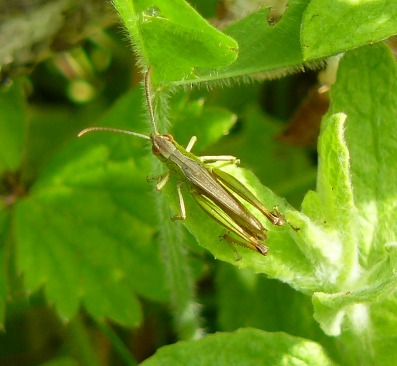
Malcolm Phillips was
on Brook Meadow yesterday and got a cracking
Painted Lady, not actually the first of the
year as Joyce Sawyer had an early one on 6 June.
Hopefully we should be getting more coming through.
Ralph Hollins was also
on Brook Meadow yesterday. He found a Dark Bush
Cricket on some low vegetation and a Southern Hawker
dragonfly, plus a Harvestman species and four common
butterfly species despite the lack of sunshine. Among
the plants noted were flowers on Cleavers (presumably
a second flowering) and single plant of Yellow Rattle
after the majority have gone to seed.
Grasshopper
App
John Arnott
told me that the long awaited free iRecord
Grasshoppers app has just launched. It is available
now for iOS and should be available for Android too.
One has the necessary smart phone or tablet, of
course.
The App covers grasshoppers, bush-crickets, true
crickets, and allies such as earwigs and stick insects
as well as recent invaders to the UK. It includes for
each species:
General information - ID, habitats, 'song'
description, etc. A diagram labelled with key ID
features. Photographs. Distribution map. Sound file
for the 'song', including a diagrammatic
representation of the song.
Most importantly, the app allow records to be sent
directly to the iRecord scheme http://www.brc.ac.uk/irecord/
so as to aid the conservation of these hitherto
under-recorded species. If you don't have a compatible
mobile device you can still to record any sightings or
check on the records without the mobile app at the
iRecord website above.
See interesting YouTube video . . . https://www.youtube.com/watch?v=EW_3pDUUWpM
For
earlier observations go to . . July
17-31